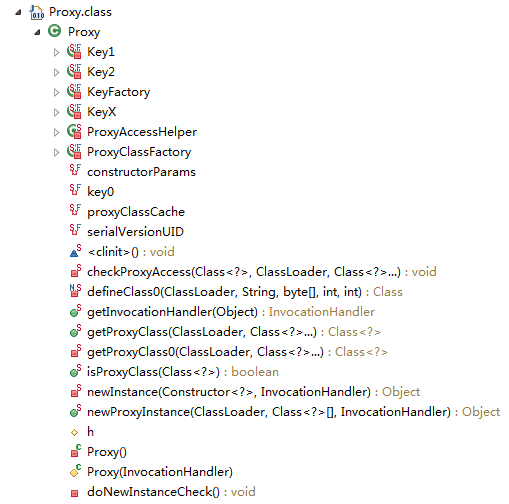Java的动态代理
例子:
1.Subject接口
public interface Subject {
public void doSomething();
public void callHome();
}
2.Subject的实现类RealSubject
public class RealSubject implements Subject {
public void doSomething() {
System.out.println("call doSomething()");
}
public void callHome() {
System.out.println("call home");
}
}
3.动态代理类DynamicProxy
import java.lang.reflect.InvocationHandler;
import java.lang.reflect.Method;
import java.lang.reflect.Proxy;
public class DynamicProxy implements InvocationHandler {
private Object proxied;
public DynamicProxy(Object proxied) {
this.proxied = proxied;
}
@SuppressWarnings("unchecked")
public <T> T getProxy() {
return (T) Proxy.newProxyInstance(proxied.getClass().getClassLoader(),
proxied.getClass().getInterfaces(), this);
}
public Object invoke(Object proxy, Method method, Object[] args)
throws Throwable {
beforeMethod();
Object object = method.invoke(proxied, args);
afterMethod();
return object;
}
public void beforeMethod() {
System.out.println("before");
}
public void afterMethod() {
System.out.println("after");
}
}
4.测试类
public class Test {
public static void main(String args[]) {
Subject proxySubject = new DynamicProxy(new RealSubject()).getProxy();
proxySubject.doSomething();
System.out.println("");
proxySubject.callHome();
}
}
测试结果
before
call doSomething()
after
before
call home
after
动态代理的JDK官方文档说明
java.lang.reflect.Proxy
Proxy provides static methods for creating dynamic proxy classes and instances, and it is also the superclass of all dynamic proxy classes created by those methods.
A dynamic proxy class (simply referred to as a proxy class below) is a class that implements a list of interfaces specified at runtime when the class is created, with behavior as described below. A proxy interface is such an interface that is implemented by a proxy class. A proxy instance is an instance of a proxy class. Each proxy instance has an associated invocation handler object, which implements the interface InvocationHandler. A method invocation on a proxy instance through one of its proxy interfaces will be dispatched to the invoke method of the instance's invocation handler, passing the proxy instance, a java.lang.reflect.Method object identifying the method that was invoked, and an array of type Object containing the arguments. The invocation handler processes the encoded method invocation as appropriate and the result that it returns will be returned as the result of the method invocation on the proxy instance.
java.lang.reflect.InvocationHandler
InvocationHandler is the interface implemented by the invocation handler of a proxy instance.
Each proxy instance has an associated invocation handler. When a method is invoked on a proxy instance, the method invocation is encoded and dispatched to the invoke method of its invocation handler.
Proxy部分JDK源码

private Proxy() {
}
protected Proxy(InvocationHandler h) {
doNewInstanceCheck();
this.h = h;
}
由于 Proxy 内部从不直接调用构造函数,所以 private 类型意味着禁止任何调用由于 Proxy 内部从不直接调用构造函数,所以 protected 意味着只有子类可以调用public static Object newProxyInstance(ClassLoader loader,
Class<?>[] interfaces,
InvocationHandler h)
throws IllegalArgumentException
{
if (h == null) {
throw new NullPointerException();
}
final Class<?>[] intfs = interfaces.clone();
final SecurityManager sm = System.getSecurityManager();
if (sm != null) {
checkProxyAccess(Reflection.getCallerClass(), loader, intfs);
}
/*
* Look up or generate the designated proxy class.
*/
Class<?> cl = getProxyClass0(loader, intfs);
/*
* Invoke its constructor with the designated invocation handler.
*/
try {
final Constructor<?> cons = cl.getConstructor(constructorParams);
final InvocationHandler ih = h;
if (sm != null && ProxyAccessHelper.needsNewInstanceCheck(cl)) {
// create proxy instance with doPrivilege as the proxy class may
// implement non-public interfaces that requires a special permission
return AccessController.doPrivileged(new PrivilegedAction<Object>() {
public Object run() {
return newInstance(cons, ih);
}
});
} else {
return newInstance(cons, ih);
}
} catch (NoSuchMethodException e) {
throw new InternalError(e.toString());
}
}
一个典型的动态代理创建对象过程可分为以下四个步骤:
1、通过实现InvocationHandler接口创建自己的调用处理器 IvocationHandler handler = new InvocationHandlerImpl(...);
2、通过为Proxy类指定ClassLoader对象和一组interface创建动态代理类
Class clazz = Proxy.getProxyClass(classLoader,new Class[]{...});
3、通过反射机制获取动态代理类的构造函数,其参数类型是调用处理器接口类型
Constructor constructor = clazz.getConstructor(new Class[]{InvocationHandler.class});
4、通过构造函数创建代理类实例,此时需将调用处理器对象作为参数被传入
Interface Proxy = (Interface)constructor.newInstance(new Object[] (handler));
为了简化对象创建过程,Proxy类中的newInstance方法封装了2~4,只需两步即可完成代理对象的创建。
生成的ProxySubject继承Proxy类实现Subject接口,实现的Subject的方法实际调用处理器的invoke方法,而invoke方法利用反射调用的是被代理对象的的方法(Object result=method.invoke(proxied,args))